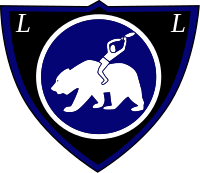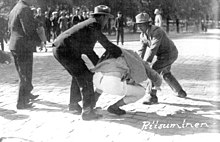Lapua Movement
This article needs additional citations for verification. (May 2012) |
| Lapua Movement | |
|---|---|
 | |
| Leader | Vihtori Kosola, , |
| Dates of operation | 1929–1932 |
| Motives | Outlawing communism in Finland (initially) Setting up right-wing dictatorship (later)[1] |
| Ideology | Finnish nationalism, Anticommunism, Fascism[2][3][4] |
| Major actions | Assault, murder, kidnapping, riot |
| Status | Outlawed in 1932 |
| Size | at least 40,000 (1930)[5] |
The Lapua Movement (Finnish: Lapuan liike, Swedish: Lapporörelsen) was a radical Finnish nationalist and anti-communist political movement founded in and named after the town of Lapua. After radicalisation it turned towards far-right politics and was banned after a failed putsch in 1932.[6] The movement's anti-communist activities continued in the parliamentarian Patriotic People's Movement.
Background[]
The Lapua Movement started in 1929 and was initially dominated by anti-communist nationalists, emphasizing the legacy of the nationalist activism, the White Guards and the Civil War in Finland. The movement saw itself as the defender of what was won in the Civil War, supporting Lutheranism, Finnish nationalism, and anti-communism.
Many politicians and high-ranking military officers were initially sympathetic to the Lapua Movement, as anti-communism was the norm in the educated classes after the Civil War. However, excessive use of violence made the movement less popular within a few months.
During the Civil War, Ostrobothnia had been one of the most important strongholds of the White army, and anti-communist sentiments remained extremely strong. Late in November 1929, the Young Communist League of Finland arranged meetings and protests in Ostrobothnian Lapua. As the nationalists saw it, the communists had "mocked God, the Lutheran Church, the 'bourgeois' fatherland, the Finnish army and General Mannerheim".[7] This infuriated many of the townspeople, who put a violent end to the meetings. Anti-communist violence was hailed as justified and praiseworthy. On 1 December an anti-communist meeting was held, attracting more than 1,000 people demanding an end to all communist activities. The movement quickly spread around the country, and in some provinces people other than communists were targeted as well, for example the group "Patriotic Citizens of Viitasaari" wanted to purge Jews and Freemasons from the country.[8]
Activities[]

Marches and meetings were arranged throughout the country. On 16 June 1930 more than 3,000 men arrived in Oulu in order to destroy the printing press and office of the communist newspaper Pohjan Voima. The last issue of Pohjan Voima had appeared on 14 June. The same day, a communist printing press in Vaasa was destroyed. A so-called "Peasant March" to Helsinki was a major show of power. More than 12,000 men arrived in Helsinki on 7 July. The government yielded under the pressure, and communist newspapers were outlawed in a "Protection of the Republic Act."
Meetings held by leftist and labour groups were also interrupted, often violently. A common tactic was "muilutus", which started with kidnapping and beating. After that the subject was thrown into a car and driven to the border with the Soviet Union. Many of the Finns deported by the Lapua Movement were later caught up in Stalin's Great Purge and executed; while persecuted in Finland as communists, Stalin accused them of being "Nationalists".[9]
The Social Democratic politician Onni Happonen was kidnapped and murdered in September 1930. On 14 October 1930 the popular ex-president Kaarlo Juho Ståhlberg and his wife were kidnapped and taken to Joensuu. After this, general support for the movement collapsed. More moderate people left the movement, and extremists became more influential.
Failed rebellion[]
In February 1932 a Social Democrat meeting in Mäntsälä was violently interrupted by armed Lapua activists. The event escalated to an attempted coup d'état known as the Mäntsälä rebellion (Mäntsälän kapina), led by the former Chief of Staff of Finland's army, General Wallenius. Despite the appeals of Wallenius, the army and the White Guards were largely loyal to the government. Many historians believe the main reason for the failure was poor planning: the event just escalated from actions of the local chapter and the national organization came aboard later.[10] The rebellion ended after President Svinhufvud gave a radio speech to the rebels. After a trial, the Lapua Movement was banned on 21 November 1932 under the Protection of the Republic Act, which Lapua itself had worked to get passed. Wallenius and about 50 other leaders were sentenced to prison.
Legacy[]

After the Lapua Movement was banned, the Patriotic People's Movement was formed shortly thereafter. Like its predecessor, it also was nationalist and anti-communist. It had limited political success and was banned in 1944 on the orders of the Soviet Union in the aftermath of the Continuation War.
See also[]
- Continuation War
- Heimosodat
- History of Finland
- Minna Craucher
- Politics of Finland
- Vaps Movement (Estonia)
- Winter War
References[]
- ^ Ylikangas, Heikki: Käännekohdat Suomen historiassa: pohdiskeluja kehityslinjoista ja niiden muutoksista uudella ajalla. Helsinki: WSOY, 1986. ISBN 9510137456.
- ^ Mühlberger, Detlef (1987). The Social Basis of European Fascist Movements. Routledge. ISBN 0709935854.
- ^ Matthew Feldman (2004). Fascism: The 'fascist epoch'. Taylor & Francis. p. 171. ISBN 978-0-415-29019-7.
- ^ Forest, James (2006). The Making of a Terrorist: Recruitment, Training and Root Causes. Westport, Connecticut: Praeger Security International.
- ^ Siltala, Juha (1985). Lapuan liike ja kyyditykset 1930. Otava. ISBN 978-951-10871-6-8.
- ^ Levitsky, Steven; Ziblatt, Daniel (2018). How Democracies Die. United States: Crown.
- ^ (Niinistö, Jussi, Suomalaisia vapaustaistelijoita / Finnish Freedom Fighters, NIMOX KY/Ltd., 2003, pages 17–20; Siltala, Juha, Lapuan liike ja kyyditykset, Otava, 1985, pages 51–53; Virkkunen, Sakari, Suomen presidentit I / Finland's Presidents I, Otava, 1994, pages 192–193; Salokangas, Raimo, "Itsenäinen tasavalta" / "An Independent Republic," page 635 in Zetterberg, Seppo et al., eds., Suomen historian pikkujättiläinen / A Small Giant of the Finnish History, WSOY, 2003).
- ^ Anttikoski, Riitta: Kun talonpojat marssivat. Helsingin Sanomat, 6.7.1980, s. 17. HS Aikakone (vain tilaajille)
- ^ Iltalehti Teema Historia: Lapuan liike, Alma Media, 2015, pp. 34–35.[ISBN missing]
- ^ Iltalehti Teema Historia: Lapuan liike, Alma Media, 2015, pp. 4–7.[ISBN missing]
- Kirby, David (2006). A concise history of Finland. Cambridge University Press. ISBN 978-0-521-53989-0.
External links[]
 Media related to Lapua Movement at Wikimedia Commons
Media related to Lapua Movement at Wikimedia Commons
- Finnish nationalism
- Political history of Finland
- Defunct political parties in Finland
- Political parties established in 1929
- Political parties disestablished in 1932
- Lapua
- 1929 establishments in Finland
- 1932 disestablishments in Finland
- Far-right politics in Finland
- Banned far-right parties
- Anti-communist organisations in Finland
- Finnish anti-communists